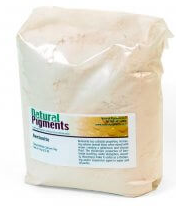| Natural Pigments LLC |

| No Title | 0.01 MB |
| Registration Date | 18 Jan 2018 |
| Revision Date | 18 Jan 2018 |
| Share |
Others Composites and Polymers Product Number : 515-15OCL
Rheology modifierOrganoclay
Nanoparticle /Nanopowder CAS Number : 1302-78-9
Organoclay (Bentone SD-1) is is an organic derivative of bentonite clay and used as a rheological additive. Mixes easily with oil and alkyd paints to increase viscosity, prevent pigment settling, and increase crispness of handling. Add 1–4% of total weight of the paint.
It provides viscosity increase, reduces sagging of coatings on vertical surfaces and prevents settling of pigments and fillers.
Organoclay is readily dispersible for non-polar to medium-polarity organic applications. It may be added at any point in the paint making process is using all normal paint-making equipment. This rheological additive can be incorporated in the pigment grind under high shear and under low shear. A chemical activator is not required to disperse the organoclay in conventional solvent containing paints.
It can be added to the pigment grind or by mixing rather than grinding. Its does, however, require some minimal shear (minimum tip speed 4 meters per second when a high speed mixer is used). The liquid paint to which it is to be added should well stirred as it is sifted in. Sufficient time for full activation should be allowed. The amount of time required will depend upon the amount of paint, the type and speed of mixer in use and the viscosity and solids of the system. When grinding with the pigment, it is not sensitive to high temperatures and no minimum temperature is required.
Making Paint: Add the cream-colored powder to the oil before adding the oil to the pigment. Stir it into the oil, using about 2 to 5% of the total weight of the paint. Grind the mixture with a muller on flat surface thoroughly to build viscosity and thixotropic properties. Allow the paint to rest for one or more hours before use.
Adding to Paint: Add the cream-colored powder to the paint with a palette knife or spatula, using about 2 to 5% of the total weight of the paint. It is highly recommended to grind the paint with a muller on flat surface thoroughly to build viscosity and thixotropic properties. Allow the paint to rest before use.
The manufacturer states that "tThe best rheological performance under letdown conditions is achieved when the system temperature is between 21 °C (70 °F) and 35 °C(95 °F). When used in the pigment grind, it is not sensitive to high temperatures and no minimum temperature is required.
Organoclay is made by modifying phyllosilicates (such as smectite, bentonite, etc.), which is a clay mineral originating from volcanic ash, with quaternary amines, a type of surfactant that contains a nitrogen ion. By exchanging the original interlayer cations for organic cations (typically quaternary alkylammonium ions) an lipophilic (oil loving) surface is created, consisting of covalently linked organic moieties. The lamellar structure remains analogous to the parent clay mineral.